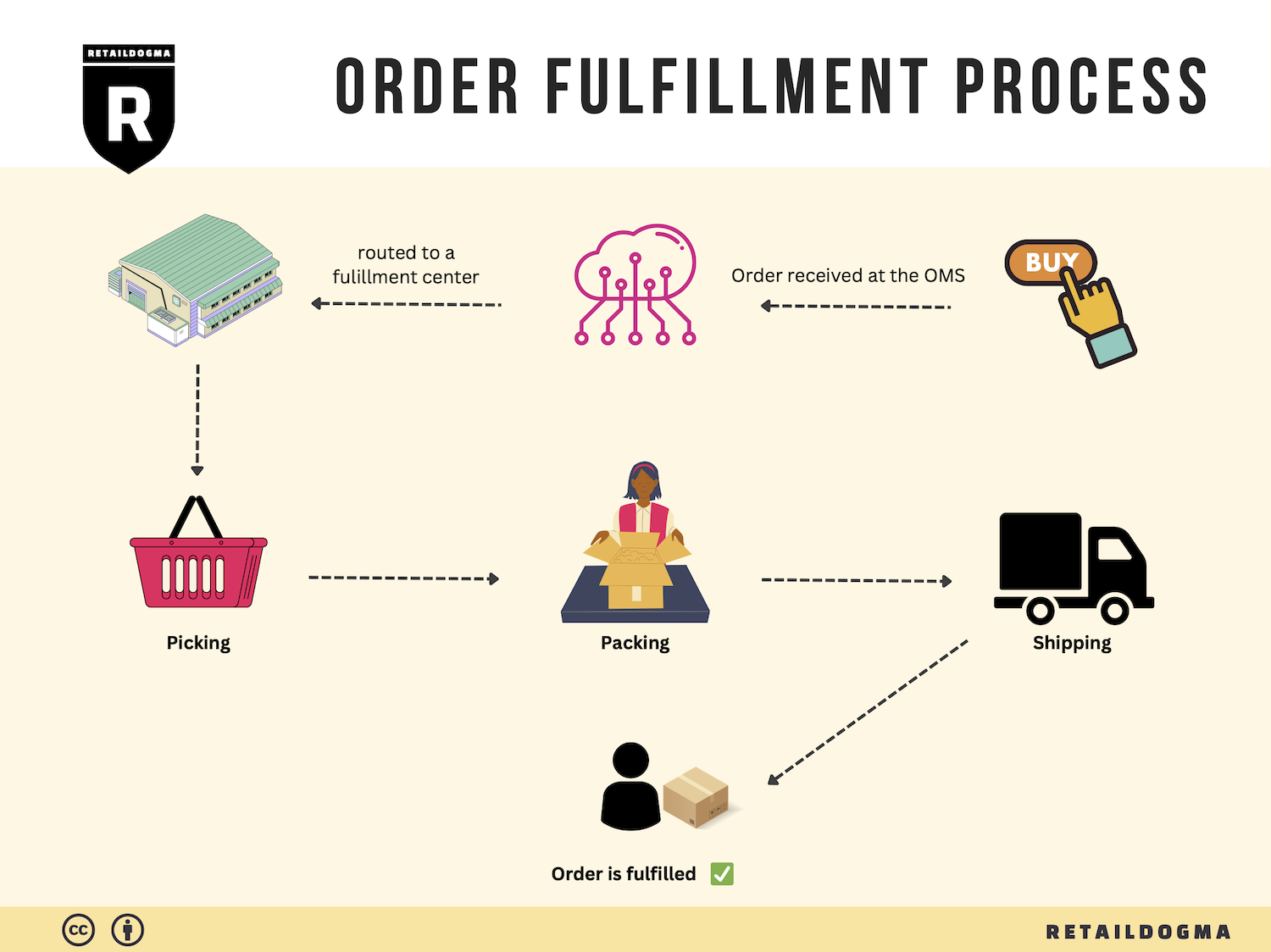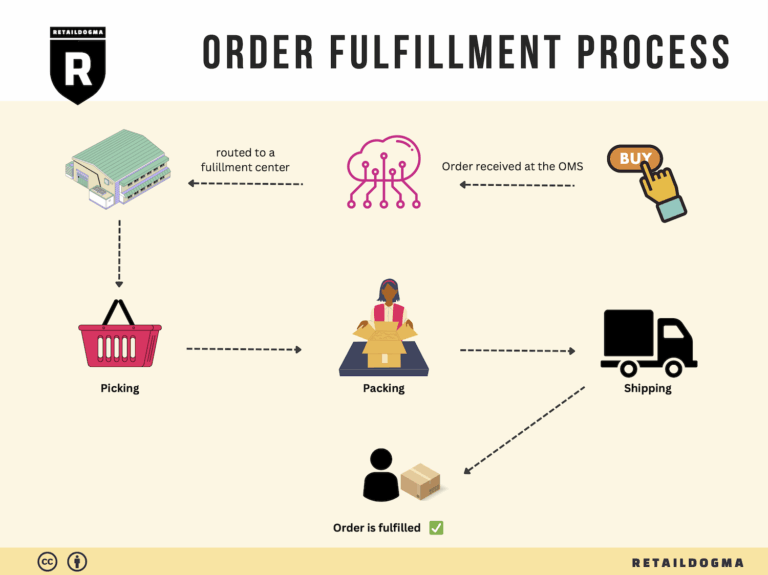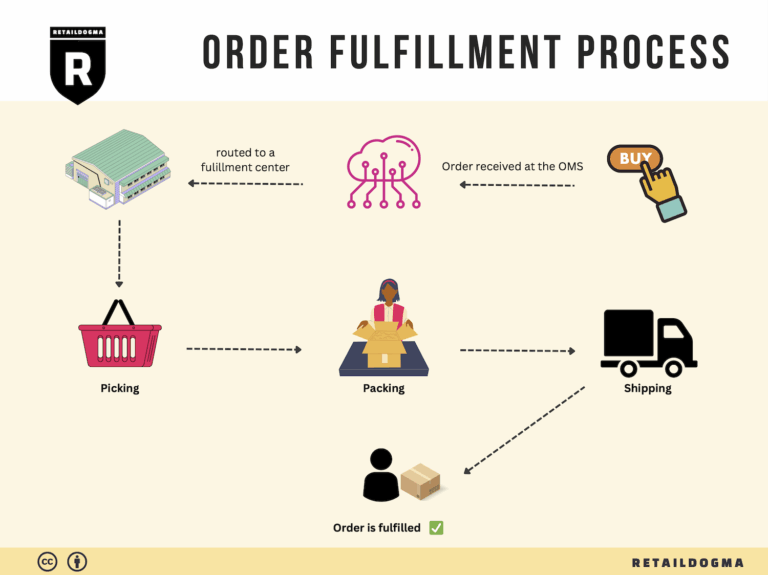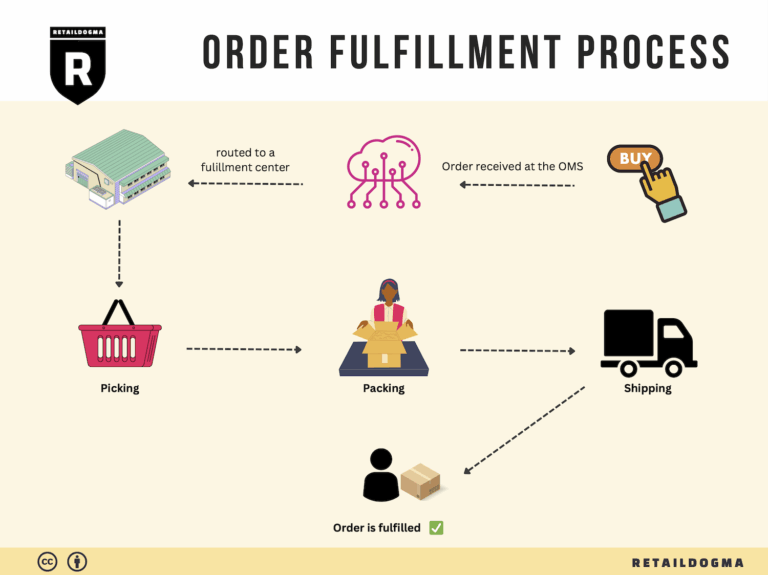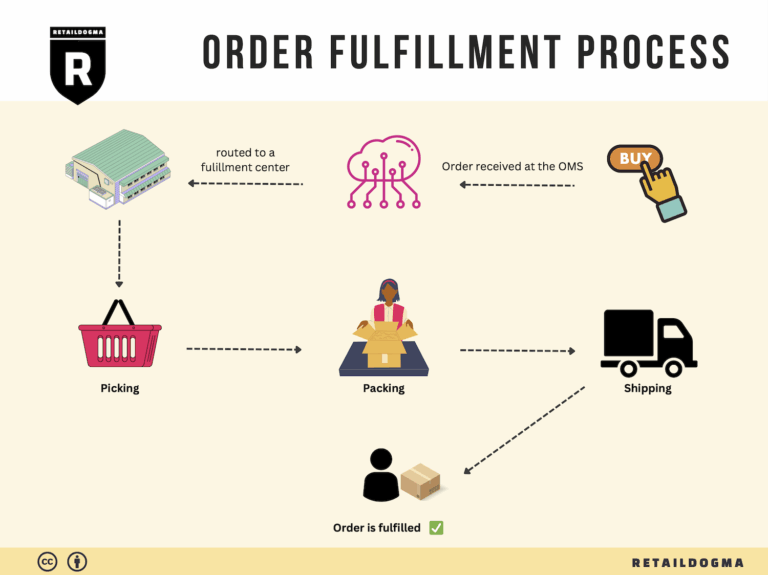What Is A Fulfillment Center? A Complete Guide (2025)
What is E-commerce Fulfillment? An Introduction for Growing Businesses
Understanding the Fulfillment Challenge
As an e-commerce business grows, many owners find themselves overwhelmed by the complexities of packing and shipping orders. Managing logistics can quickly become a daunting task, consuming valuable time and resources that could be better spent on scaling your business. The fulfillment process—essentially the journey of getting a product from your inventory to the customer’s doorstep—can be intricate, involving multiple steps, including inventory management, order processing, packing, and shipping. When not handled efficiently, these processes can lead to delays, increased costs, and dissatisfied customers.
What is E-commerce Fulfillment?
E-commerce fulfillment refers to the entire process of receiving, processing, and delivering orders to customers. This encompasses everything from warehousing products to picking and packing them, shipping orders, and handling returns. For growing businesses, understanding the nuances of fulfillment is crucial to maintaining customer satisfaction and operational efficiency.
What This Guide Covers
In this guide, we will explore various fulfillment models that can meet the unique needs of your business. You will learn about:
-
Third-Party Logistics (3PL): Understand how partnering with a 3PL provider can streamline your operations, allowing you to focus on growth while they handle the logistics.
-
Fulfillment by Amazon (FBA): Discover how Amazon’s fulfillment services can offer scalability and access to their vast distribution network, potentially increasing your reach and sales.
-
Core Services: We will outline the essential services provided by fulfillment partners, including inventory management, order processing, packing, shipping, and returns management.
-
Choosing the Right Partner: Learn how to evaluate potential fulfillment partners based on your business needs, service quality, and scalability options.
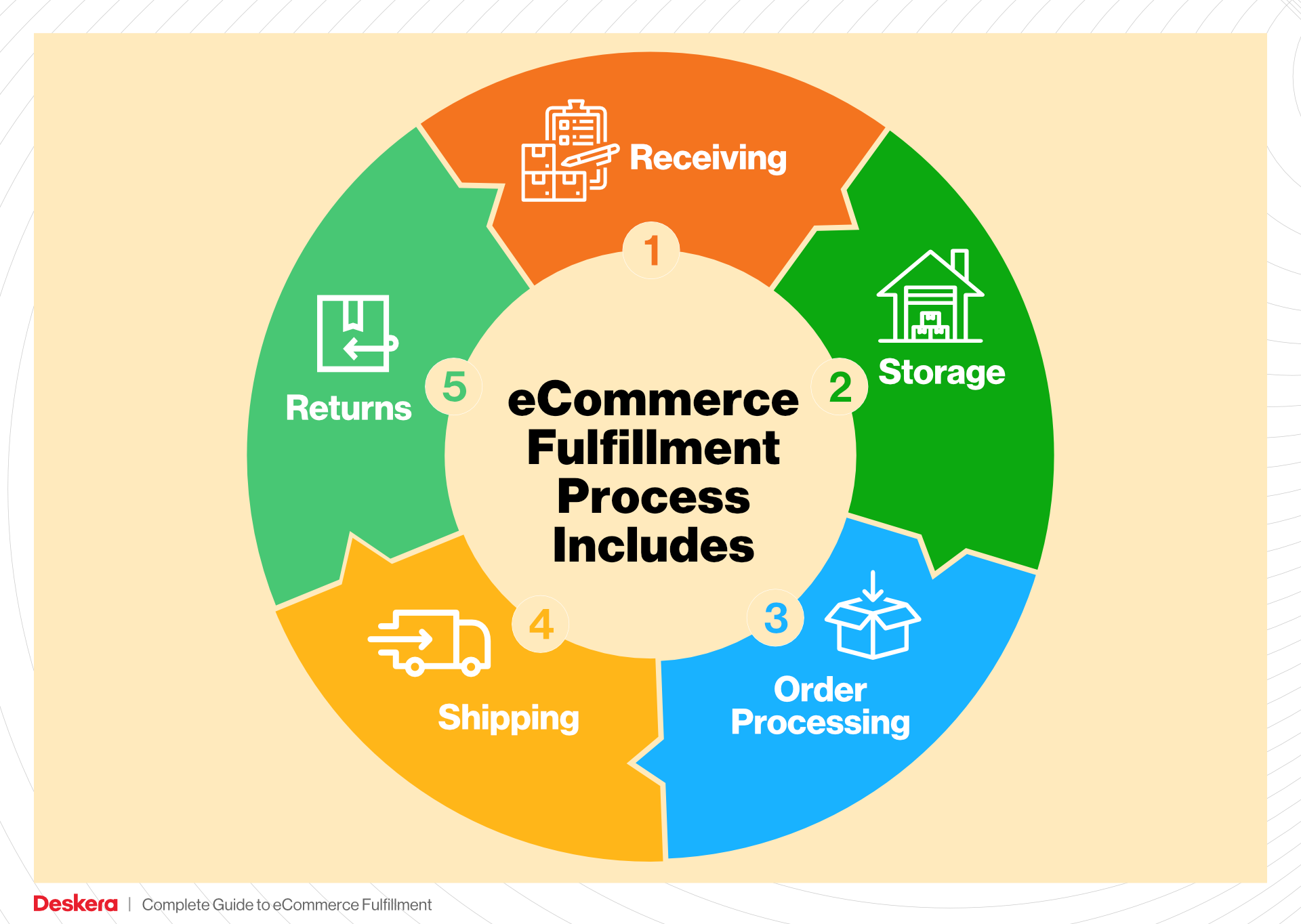
-
Pricing Models: Gain insights into different pricing structures used by fulfillment providers, helping you to budget effectively and avoid unexpected costs.
Empowering Your Business Decisions
The ultimate goal of this guide is to empower you as a business owner or operations manager to make informed decisions about your logistics. By understanding the various fulfillment options available, you can select the right model and partner that aligns with your growth objectives. With the right fulfillment strategy in place, you can enhance your operational efficiency, improve customer satisfaction, and pave the way for sustainable business growth. Let’s dive in and demystify the world of e-commerce fulfillment together.
What You’ll Learn In This Guide
- What is E-commerce Fulfillment? An Introduction for Growing Businesses
- The Order Fulfillment Process: From ‘Buy’ Button to Customer’s Door
- Comparing Fulfillment Models: In-House vs. 3PL vs. Dropshipping
- A Deep Dive into Amazon FBA: Pros, Cons, and Who It’s For
- Core Services Offered by Fulfillment Centers
- How to Choose a Fulfillment Partner: A 6-Point Checklist
- Understanding Fulfillment Pricing: A Breakdown of Common Fees
- Frequently Asked Questions (FAQs) about Fulfillment
- Conclusion: Is Outsourcing Fulfillment the Right Move for Your Business?
- Important Disclaimer
The Order Fulfillment Process: From ‘Buy’ Button to Customer’s Door
1. Receiving Inventory
The first step in the order fulfillment process is receiving inventory. When products arrive at the fulfillment center, they undergo a thorough inspection to verify their quantity and condition against the purchase order. This process is crucial for maintaining accurate inventory levels and ensuring that only quality products are stored for future orders.
A key term associated with this step is SKU (Stock Keeping Unit), a unique identifier assigned to each product. SKUs facilitate inventory management by allowing for quick tracking and identification of items. Efficient receiving processes help prevent stock discrepancies, which can lead to fulfillment errors and customer dissatisfaction. Implementing a robust receiving system also establishes a foundation for effective inventory management, which is vital for scaling your business.
2. Warehouse Storage
Once inventory is received and verified, the next step is warehouse storage. Products are organized and stored in designated areas within the fulfillment center. This organization is often determined by product type, size, and turnover rate, optimizing space and accessibility.
The importance of this step lies in its impact on the overall efficiency of the fulfillment process. A well-organized warehouse reduces the time required to locate and retrieve items for orders, thereby increasing order fulfillment speed. A key term here is ABC Analysis, a method that categorizes inventory into three classes (A, B, and C) based on their importance and turnover rates. This classification helps prioritize storage space for high-demand items, ensuring that they are readily accessible when needed.
3. Order Picking
The third step in the fulfillment process is order picking. Once a customer places an order, the fulfillment center generates a pick list that outlines the items to be retrieved from the warehouse. Workers then navigate the warehouse to collect these items, ensuring that orders are filled accurately and efficiently.
This step is critical as it directly impacts order accuracy and customer satisfaction. Errors during picking can lead to delays and dissatisfaction, potentially harming your business’s reputation. A key term associated with this process is pick lists, which are detailed documents that guide workers in selecting the correct items. Implementing technology, such as barcode scanning or automated picking systems, can further streamline this process, reduce human error, and enhance operational efficiency.
4. Order Packing
After items are picked, they move to the order packing stage. This step involves securely packaging products for shipment, ensuring that they are protected during transit. Proper packing is essential to prevent damage and returns, which can incur additional costs and impact customer satisfaction.
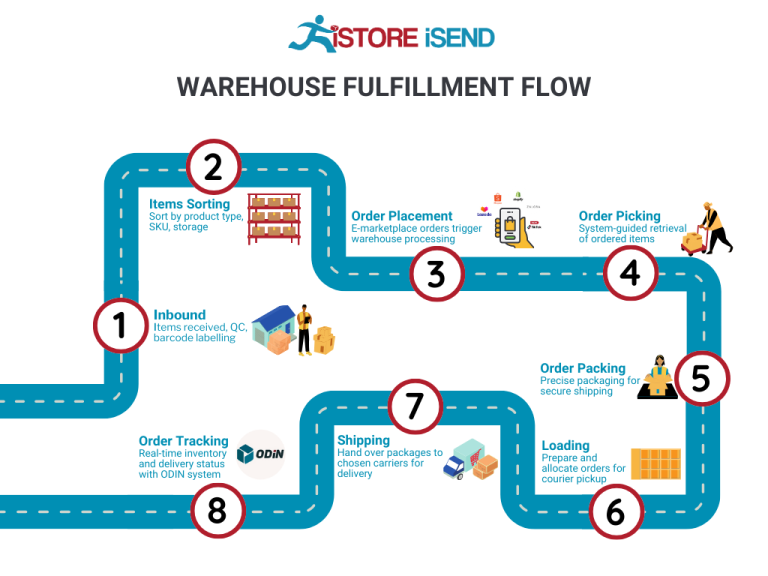
The significance of this step cannot be overstated, as it also involves labeling packages for shipping. A critical term here is packaging materials, which include boxes, padding, and tape, all chosen based on the product’s fragility and shipping requirements. Efficient packing processes not only protect the products but also enhance the unboxing experience for customers, which can lead to positive reviews and repeat purchases. Utilizing custom packaging solutions can further elevate your brand’s image and customer satisfaction.
5. Shipping & Delivery
The final step in the order fulfillment process is shipping and delivery. Once packages are packed, they are handed over to shipping carriers for delivery to the customer. This stage encompasses selecting the appropriate shipping method, generating tracking information, and ensuring that packages are dispatched promptly.
Shipping speed and reliability are crucial factors in customer satisfaction. A key term associated with this step is last-mile delivery, which refers to the final leg of the delivery journey from the distribution center to the customer’s doorstep. Investing in efficient last-mile solutions can significantly enhance customer experiences and reduce shipping costs. Monitoring carrier performance and leveraging technology for real-time tracking can further improve transparency and communication with customers, ensuring they are informed about their order status.
By mastering these five steps—receiving inventory, warehouse storage, order picking, order packing, and shipping & delivery—e-commerce businesses can create a streamlined order fulfillment process that enhances operational efficiency and customer satisfaction, ultimately supporting growth and scalability in a competitive marketplace.
Comparing Fulfillment Models: In-House vs. 3PL vs. Dropshipping
Fulfillment Models Overview
When scaling an e-commerce business, selecting the right fulfillment model is critical for operational efficiency and customer satisfaction. Below is a comparison of three predominant fulfillment models: In-House Fulfillment, Third-Party Logistics (3PL), and Dropshipping. Each model has its unique characteristics, advantages, and disadvantages that can significantly impact your business operations.
| Model | Who Handles Inventory | Best For (Business Stage) | Key Advantage | Key Disadvantage |
|---|---|---|---|---|
| In-House Fulfillment | The business itself | Established businesses | Full control over inventory and fulfillment processes | High overhead costs |
| Third-Party Logistics (3PL) | A third-party provider | Growing businesses | Scalable and flexible operations | Less control over logistics |
| Dropshipping | Supplier/Manufacturer | Startups and small businesses | Low upfront investment | Lower profit margins |
In-House Fulfillment
In-House Fulfillment is a model where the business manages all aspects of inventory storage, order processing, and shipping internally. This approach is often favored by established businesses that have the resources to maintain their own warehouse and logistics operations.
Advantages: The primary advantage of in-house fulfillment is the level of control it offers. Businesses can oversee inventory management, quality control, and the entire shipping process, ensuring that customer expectations are met consistently. This model allows for tailored logistics solutions, which can enhance customer service and satisfaction. Additionally, businesses can implement their own technology solutions, such as warehouse management systems, to optimize operations.
Disadvantages: However, in-house fulfillment comes with significant overhead costs. Maintaining a warehouse requires substantial investment in infrastructure, labor, and technology. As a business scales, these costs can escalate quickly. Furthermore, the operational complexity of managing logistics can divert focus from core business activities, such as marketing and product development.
Third-Party Logistics (3PL)
Third-Party Logistics (3PL) involves outsourcing logistics operations to a specialized provider. In this model, a 3PL company manages inventory storage, order fulfillment, and shipping on behalf of the business. This model is particularly beneficial for growing businesses that need to scale their operations without the burden of managing logistics in-house.
Advantages: One of the key advantages of using a 3PL is scalability. As demand fluctuates, businesses can easily adjust their logistics needs without the need for significant capital investment. 3PL providers typically have established networks and expertise in logistics, which can lead to improved shipping efficiency and reduced costs. Additionally, businesses can benefit from the technology and logistics innovations that 3PL providers offer, such as advanced tracking systems and optimized shipping routes.
Disadvantages: A notable disadvantage of 3PL is the potential loss of control over logistics processes. Businesses must rely on the 3PL provider to meet service level agreements, which can sometimes lead to inconsistencies in customer service. Furthermore, the cost structure of 3PL can be complex, and hidden fees may arise, impacting overall profitability.

Dropshipping
Dropshipping is a fulfillment model where the retailer does not keep goods in stock. Instead, when a customer places an order, the retailer purchases the item from a third party (usually a manufacturer or wholesaler) who then ships it directly to the customer. This model is particularly appealing for startups and small businesses that want to minimize upfront costs.
Advantages: The primary advantage of dropshipping is the low financial barrier to entry. Retailers can offer a wide range of products without the need for significant investment in inventory or warehousing. This model allows entrepreneurs to test various products and markets with minimal risk, making it an attractive option for those just starting out.
Disadvantages: On the downside, dropshipping often results in lower profit margins compared to in-house fulfillment or 3PL. Retailers typically pay wholesale prices to suppliers, which can limit their pricing flexibility. Additionally, since the retailer relies on third parties for inventory management and shipping, issues such as stockouts or shipping delays can occur, leading to customer dissatisfaction. Quality control can also be a challenge, as retailers have little oversight over the products being shipped.
Conclusion
In choosing the right fulfillment model, businesses must consider their current stage, operational capabilities, and long-term goals. Each model has its strengths and weaknesses, and the decision will significantly impact logistics efficiency, customer satisfaction, and overall profitability. By carefully evaluating the pros and cons of In-House Fulfillment, 3PL, and Dropshipping, e-commerce business owners can select a fulfillment strategy that aligns with their operational needs and growth ambitions.
A Deep Dive into Amazon FBA: Pros, Cons, and Who It’s For
Understanding Fulfillment by Amazon (FBA)
Fulfillment by Amazon (FBA) is a service provided by Amazon that allows sellers to store their products in Amazon’s fulfillment centers. Amazon takes care of storage, packaging, and shipping, as well as customer service and returns. This service enables sellers to leverage Amazon’s vast logistics network and customer base, enhancing their operational efficiency and market reach.
How FBA Works
-
Product Listing and Shipping to Amazon: Sellers create product listings on Amazon and ship their inventory to Amazon’s fulfillment centers. Sellers can choose to send their entire inventory to one location or distribute it across multiple centers.
-
Storage: Once the products arrive at Amazon’s fulfillment centers, they are stored until an order is placed. Amazon manages the inventory, ensuring products are stored in optimal conditions.
-
Order Fulfillment: When a customer orders a product, Amazon picks, packs, and ships it directly to the customer. This process is typically completed within 24 hours, ensuring fast delivery.
-
Customer Service and Returns: Amazon handles all customer service inquiries and processes returns, providing a seamless experience for both sellers and customers.
-
Performance Metrics: Sellers can track their performance through Amazon Seller Central, which provides insights into sales, inventory levels, and customer feedback.
Pros of Using Amazon FBA
-
Prime Eligibility: Products fulfilled through FBA are automatically eligible for Amazon Prime, allowing sellers to reach millions of Prime members. This can significantly increase sales, as Prime members are more likely to purchase items that offer fast and free shipping.
-
Customer Trust: Selling through Amazon’s platform with FBA boosts customer trust. Buyers often feel more secure purchasing from a seller that uses Amazon’s fulfillment service, as they expect reliable shipping and customer support.
-
Multi-Channel Fulfillment: FBA allows sellers to fulfill orders from other channels (e.g., their own website or eBay) using Amazon’s logistics. This feature can streamline operations for sellers who sell across multiple platforms, consolidating shipping and inventory management.
-
Scalability: FBA makes it easier for businesses to scale operations. Sellers can manage larger volumes of orders without the need to invest in their own warehousing and logistics infrastructure.
-
Focus on Growth: With Amazon handling logistics, sellers can focus on marketing, product development, and other strategic areas rather than day-to-day fulfillment operations.
Cons of Using Amazon FBA
-
High Fees: FBA incurs various fees, including storage fees for unsold inventory and fulfillment fees for each item sold. These costs can add up quickly, particularly for sellers with low-margin products or those with slow-moving inventory.
-
Strict Inventory Rules: Amazon has stringent guidelines regarding inventory management. Sellers must adhere to specific storage limits, and failing to comply can lead to penalties or even account suspension. Moreover, sellers must manage their inventory carefully to avoid long-term storage fees.
-
Commingling Risks: FBA products are often commingled, meaning that items from different sellers are stored together. This can pose risks for sellers, such as counterfeit products being sent to customers or issues with returns and refunds.
-
Loss of Control: When using FBA, sellers relinquish some control over the fulfillment process. Issues such as packaging, shipping errors, or customer service interactions are managed by Amazon, which may not always align with the seller’s brand standards.
-
Limited Customization: FBA offers limited options for branding and customization in packaging. This can be a disadvantage for sellers who wish to create a unique unboxing experience for their customers.
Who is FBA Best For?
FBA is particularly beneficial for small to medium-sized e-commerce businesses looking to scale quickly without the burden of managing logistics themselves. It is ideal for:
-
Entrepreneurs Launching New Products: FBA allows new sellers to enter the market with minimal upfront investment in infrastructure, enabling them to focus on product development and marketing.
-
Established Brands Expanding Reach: Brands looking to expand their reach and leverage Amazon’s logistics can benefit significantly from FBA, especially if they already have a loyal customer base.
-
Sellers with High Sales Volume: Those with a steady flow of sales can benefit from the efficiency of FBA, as the cost of fulfillment can be offset by the increased sales velocity.
-
Multi-Channel Retailers: Businesses that sell through multiple online platforms can streamline their operations using FBA for order fulfillment across all channels.
In conclusion, while FBA offers numerous advantages in terms of convenience, scalability, and customer trust, it also comes with challenges such as costs and potential loss of control. E-commerce business owners should carefully weigh these factors to determine if FBA aligns with their operational goals and business model.
Core Services Offered by Fulfillment Centers
Inventory Management & Warehousing
Fulfillment centers play a pivotal role in the inventory management and warehousing of e-commerce businesses. This service involves the systematic storage of goods in a controlled environment, allowing businesses to efficiently track and manage their inventory levels. Advanced inventory management systems employed by fulfillment centers enable real-time tracking of stock levels, ensuring that businesses have a clear understanding of their available inventory.
The benefits of robust inventory management are manifold. First, it minimizes the risk of stockouts, which can lead to lost sales and dissatisfied customers. By having accurate inventory data, businesses can make informed decisions about reordering and stock replenishment, thus optimizing their supply chain operations. Additionally, fulfillment centers often provide flexible storage solutions, allowing businesses to scale their inventory up or down based on seasonal demand fluctuations without the need for significant capital investment in physical space. This adaptability is crucial for e-commerce businesses aiming to grow while managing costs effectively.
Pick and Pack Services
Pick and pack services are at the heart of fulfillment operations. This process involves selecting items from the warehouse inventory (picking) and packaging them for shipment (packing). Fulfillment centers utilize sophisticated order management systems that streamline this process, ensuring accuracy and efficiency. Orders are picked according to specific protocols, which can include batch picking, wave picking, or zone picking, depending on the volume and complexity of the orders.
The primary benefit of pick and pack services is the speed and accuracy with which orders are fulfilled. E-commerce businesses often face tight shipping deadlines, and efficient pick and pack operations can significantly reduce order processing times. Additionally, fulfillment centers leverage automation and technology, such as barcode scanning and robotics, to minimize human error, ensuring that customers receive the correct items in a timely manner. This precision not only enhances customer satisfaction but also reduces return rates, contributing to a healthier bottom line.
Kitting and Assembly
Kitting and assembly services offered by fulfillment centers are essential for businesses that sell products requiring bundling or assembly before shipping. This service involves combining multiple products into a single package or constructing products from individual components. For example, a business might offer a gift set that includes several items packaged together or require the assembly of furniture pieces before they are sent to customers.
The advantages of kitting and assembly services are significant. They enable businesses to offer unique product bundles that enhance customer value and can lead to increased average order value. Furthermore, this service reduces the complexity for businesses, allowing them to outsource the labor-intensive tasks associated with product assembly and packaging. As a result, companies can focus more on their core competencies, such as marketing and product development, while ensuring that their customers receive high-quality, ready-to-use products. Additionally, fulfillment centers often have the expertise and equipment necessary to carry out these tasks efficiently, further improving operational effectiveness.
Returns Management (Reverse Logistics)
Returns management, or reverse logistics, is an often overlooked yet crucial service provided by fulfillment centers. This process involves handling product returns from customers, which includes receiving returned items, inspecting them, restocking them if they are in good condition, and managing any necessary refunds or exchanges. Effective returns management is essential for maintaining customer trust and satisfaction in the e-commerce environment.
The benefits of efficient returns management are profound. First, it helps to streamline the return process, making it easier for customers to return products without frustration. A simplified return process can enhance customer loyalty, as consumers are more likely to shop with businesses that offer hassle-free returns. Furthermore, fulfillment centers can often reprocess returned items quickly, minimizing losses by restocking sellable items and reducing the time they are out of inventory. This capability is particularly important for e-commerce businesses that rely on fast-moving inventory and wish to maximize their profitability by minimizing the impact of returns on their overall operations.
In conclusion, the core services offered by fulfillment centers—inventory management and warehousing, pick and pack services, kitting and assembly, and returns management—are integral to the success of e-commerce businesses. By leveraging these services, businesses can enhance operational efficiency, improve customer satisfaction, and scale their operations effectively. As e-commerce continues to grow, partnering with a capable fulfillment center can be a strategic move that drives long-term success.
How to Choose a Fulfillment Partner: A 6-Point Checklist
Location & Warehouse Network
Importance: The geographical location of your fulfillment partner’s warehouses can significantly affect shipping times, costs, and overall service quality. A partner with strategically placed warehouses can reduce transit times and shipping expenses, which enhances customer satisfaction.
Questions to Ask:
– What is the location of your warehouses, and how does this align with my target customer base?
– Can you provide coverage maps that show your shipping zones?
– How do you handle shipping to international locations?
– What are your average shipping times from each warehouse?
Technology & Integrations
Importance: In today’s e-commerce landscape, technology plays a crucial role in the efficiency of order fulfillment. A partner with advanced technology can streamline operations, offer real-time tracking, and integrate seamlessly with your existing systems (like your e-commerce platform).
Questions to Ask:
– What order management system do you use, and how does it integrate with my existing platforms (e.g., Shopify, WooCommerce, Amazon)?
– Can you provide real-time inventory tracking and reporting?
– How do you handle updates or changes in order status?
– What is your approach to data security and compliance?
Specializations (e.g., Cold Storage, Oversized Items)
Importance: Depending on your product range, you may need a partner that specializes in certain types of storage or handling. This is especially relevant for businesses dealing with perishables, hazardous materials, or oversized items.
Questions to Ask:
– Do you have specialized facilities or equipment for handling specific product types (e.g., temperature-controlled storage, heavy-lift equipment)?
– What protocols do you have in place for managing inventory that requires special handling?
– How do you ensure compliance with regulations related to specialized goods?
– Can you accommodate seasonal fluctuations in inventory levels for specialized products?
Scalability & Capacity
Importance: As your business grows, your fulfillment needs will likely change. A partner that can scale with you will help prevent disruptions and ensure that you can meet customer demands without compromising service quality.
Questions to Ask:
– What is your current capacity for handling orders, and how do you manage fluctuations in demand?
– Can you accommodate sudden increases in order volume, such as during peak seasons?
– What is your process for onboarding new clients, and how quickly can you scale up operations?
– How do you handle inventory overflow or storage needs during peak periods?
Pricing and Contracts
Importance: Understanding the cost structure and contractual obligations is essential to ensure that you can maintain profitability while leveraging third-party fulfillment services. Transparent pricing helps avoid unexpected costs and ensures that your financial expectations align with your partner’s offerings.
Questions to Ask:
– Can you provide a detailed breakdown of your pricing model (e.g., storage fees, pick-and-pack fees, shipping rates)?
– Are there any additional costs that I should be aware of (e.g., penalties for late shipments or minimum order quantities)?
– What is the length of the contract, and what are the terms for termination or renewal?
– How do you handle pricing adjustments, and what notice will I receive for any changes?
Customer Support & Reviews
Importance: Reliable customer support is vital for addressing issues quickly and efficiently. Additionally, understanding the experiences of other clients can provide insights into the partner’s reliability and service quality.
Questions to Ask:
– What customer support options do you offer (e.g., phone, email, live chat), and what are your hours of operation?
– How do you handle order discrepancies or fulfillment errors?
– Can you provide references or case studies from other clients in my industry?
– What is your approach to gathering and acting on customer feedback?
Conclusion
Choosing the right fulfillment partner is crucial for the success of your e-commerce business. By considering these six critical factors—location, technology, specializations, scalability, pricing, and customer support—you can make an informed decision that aligns with your business goals and enhances your operational efficiency. As you navigate this selection process, remember that a strong fulfillment partner can not only improve your logistics but also enhance your overall customer experience, driving growth and success for your brand.
Understanding Fulfillment Pricing: A Breakdown of Common Fees
Initial Setup Fees
When you start using a fulfillment center like Amazon’s KRB3, you may encounter initial setup fees. These fees cover the costs associated with onboarding your business onto the fulfillment platform. This could include account setup, integration with your e-commerce platform, and initial inventory assessment.
Typically, the initial setup fee is a one-time charge and can vary widely based on the complexity of your operations and the volume of your inventory. For instance, businesses with advanced integration needs or a large number of SKUs may incur higher fees. It’s essential to inquire about any hidden costs during the onboarding process to avoid surprises later.
Receiving Fees
Receiving fees are charged when your products arrive at the fulfillment center. These fees cover the costs associated with unloading, inspecting, and storing your inventory. Generally, receiving fees are calculated per pallet or per carton, depending on how your goods are packed.
The rate for receiving fees can vary based on the size and weight of your products. For instance, larger or heavier items may incur higher fees than smaller items. Some fulfillment centers may also charge additional fees for special handling or for products that require inspection or repackaging. It’s advisable to understand the criteria for receiving fees to manage your inventory costs effectively.
Storage Fees (per pallet/bin)
Storage fees are charged for the space your inventory occupies within the fulfillment center. These fees can be assessed on a monthly basis and are typically calculated per pallet or per bin.
Storage fees often vary based on the time of year; for example, many fulfillment centers implement higher rates during peak seasons, such as the holidays, when storage demand is high. Additionally, if your inventory remains stagnant for an extended period, you may encounter long-term storage fees. To minimize storage costs, consider optimizing your inventory turnover and maintaining a lean inventory strategy.
Pick & Pack Fees (per item/order)
Pick and pack fees are charged for the labor involved in retrieving your products from storage and preparing them for shipment. These fees are typically calculated per item or per order.
The structure of pick and pack fees can vary. Some fulfillment centers may charge a flat fee for each order processed, while others may charge based on the number of items included in an order. Additionally, if your products require special packaging or handling, you may incur extra charges. Understanding the pick and pack fee structure is crucial for accurately forecasting your fulfillment costs.
Shipping Fees
Shipping fees are incurred when your products are sent out to customers. These fees can vary based on several factors, including the shipping method chosen (standard, expedited, etc.), the destination, and the size and weight of the package.
Fulfillment centers often have partnerships with major carriers, which can provide discounted shipping rates. However, it’s important to review the pricing model for shipping carefully, as some centers may charge additional handling fees on top of the carrier rates. Understanding the shipping fees associated with your fulfillment center will help you offer competitive shipping options to your customers while maintaining profitability.
Tips for Getting an Accurate Quote
-
Understand Your Needs: Clearly define your fulfillment requirements, including the types of products you sell, your anticipated order volume, and any special handling needs. This information will help fulfillment centers provide tailored quotes.
-
Request Detailed Breakdowns: Ask for a detailed breakdown of all potential fees, including initial setup, receiving, storage, pick and pack, and shipping fees. This transparency will help you understand the total cost of fulfillment.
-
Compare Quotes: Don’t settle for the first quote you receive. Comparing multiple fulfillment centers will give you a better perspective on pricing and services offered.
-
Negotiate Terms: Some fulfillment centers may be open to negotiation, especially if you are bringing a significant amount of business. Discuss potential discounts for higher volumes or long-term contracts.
-
Consider Hidden Fees: Inquire about any potential hidden fees that may not be included in the initial quote, such as charges for returns, special handling, or long-term storage.
By understanding these common fulfillment pricing models and following these tips, you can better navigate the complexities of fulfillment costs and make informed decisions that will benefit your e-commerce business.
Frequently Asked Questions (FAQs) about Fulfillment
1. What is the Amazon Fulfillment Center KRB3?
The Amazon Fulfillment Center KRB3 is a state-of-the-art logistics facility located in the United States, designed to efficiently store, pick, pack, and ship products to customers. This center operates under Amazon’s broader fulfillment network, which is integral to delivering on Amazon’s promise of fast and reliable shipping.
2. How does the fulfillment process work at KRB3?
At KRB3, the fulfillment process begins when an order is placed. The facility uses advanced technology and systems to locate the items in the warehouse. Fulfillment associates then pick the items, pack them into boxes, and prepare them for shipment. The packages are then dispatched to the appropriate delivery service for final delivery to the customer.
3. What technology is used in the KRB3 fulfillment center?
KRB3 employs cutting-edge technology, including automated sorting systems, robotics, and artificial intelligence, to enhance the efficiency of the fulfillment process. These technologies help streamline operations, reduce errors, and speed up the time it takes to fulfill orders.
4. What’s the difference between a warehouse and a fulfillment center?
A warehouse primarily serves as a storage space for goods, often focusing on bulk storage and inventory management. In contrast, a fulfillment center is specialized for processing customer orders, which includes picking, packing, and shipping items directly to consumers. Fulfillment centers like KRB3 are designed for speed and efficiency in order fulfillment.
5. What is a 3PL?
A 3PL, or third-party logistics provider, is a company that offers logistics services to businesses, including warehousing, fulfillment, and transportation. Businesses often partner with 3PLs to outsource their logistics operations, allowing them to focus on core activities like sales and marketing while leveraging the expertise and infrastructure of the 3PL.
6. How much do fulfillment services cost?
The cost of fulfillment services can vary based on several factors, including the volume of orders, the complexity of the fulfillment process, storage fees, and shipping costs. Typically, fulfillment centers charge per order, per item, and may have additional fees for storage or special handling. It’s advisable for businesses to request quotes from multiple providers to find the best fit for their needs.
7. What are the benefits of using Amazon’s fulfillment services?
Using Amazon’s fulfillment services offers several advantages, including access to Amazon’s vast logistics network, faster shipping times, and the ability to scale operations quickly. Additionally, businesses can benefit from Amazon’s customer service and returns handling, enhancing the overall customer experience.
8. Can I track my orders fulfilled by KRB3?
Yes, orders fulfilled by KRB3 can be tracked through the Amazon platform. Once an order is shipped, customers receive a tracking number that allows them to monitor the delivery status in real-time, providing transparency and enhancing customer satisfaction.
9. How can I optimize my inventory for fulfillment at KRB3?
To optimize your inventory for fulfillment at KRB3, consider implementing an inventory management system that tracks stock levels, sales trends, and reorder points. Additionally, regularly analyzing sales data can help you identify fast-moving items and adjust your inventory accordingly, ensuring you have the right products available when needed.
10. What should I consider when selecting a fulfillment center?
When selecting a fulfillment center like KRB3, consider factors such as location, technology capabilities, scalability, cost structure, and the range of services offered. It’s also important to evaluate the provider’s track record in terms of reliability, customer service, and handling returns, as these elements will significantly impact your business’s operational efficiency and customer satisfaction.
Conclusion: Is Outsourcing Fulfillment the Right Move for Your Business?
Evaluating the Benefits of Outsourcing Fulfillment
Outsourcing fulfillment can be a transformative decision for e-commerce businesses aiming for growth. One of the most significant benefits is the time-saving aspect. By partnering with a fulfillment service, you can redirect your focus from the complexities of logistics to core business activities such as marketing, product development, and customer engagement. This shift allows you to innovate and respond to market demands more rapidly.
Another crucial advantage is scalability. As your sales increase, managing inventory, shipping, and returns can become overwhelming. A fulfillment partner can scale operations efficiently, accommodating fluctuating demand without the need for substantial investments in warehousing and labor. This flexibility ensures that you can grow without the operational headaches that typically accompany increased sales volume.
Furthermore, leveraging the expertise of a fulfillment service can enhance your business operations. These partners often bring advanced technologies and seasoned professionals who understand the intricacies of logistics, inventory management, and shipping regulations. Their knowledge can lead to improved delivery times and customer satisfaction, which are vital for retaining loyal customers in a competitive market.
Choosing the right fulfillment partner is critical to your business’s success. A thorough evaluation of potential partners should include their capabilities, technology, customer service, and alignment with your business goals.
Next Steps for Your Business
To determine if outsourcing fulfillment is the right move for your business, consider conducting an audit of your current shipping process. Assess your operational bottlenecks, costs, and customer feedback. This analysis will provide insights into whether a fulfillment partner could enhance your efficiency and support your growth ambitions. By making informed decisions, you position your business to thrive in an increasingly competitive landscape.
Important Disclaimer
⚠️ Important Disclaimer
The information in this guide is for educational purposes. Fulfillment services, pricing, and platform features change frequently. Always conduct your own due diligence and consult with providers directly before making business decisions.
